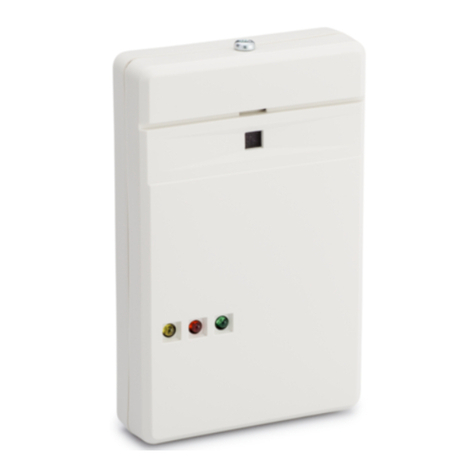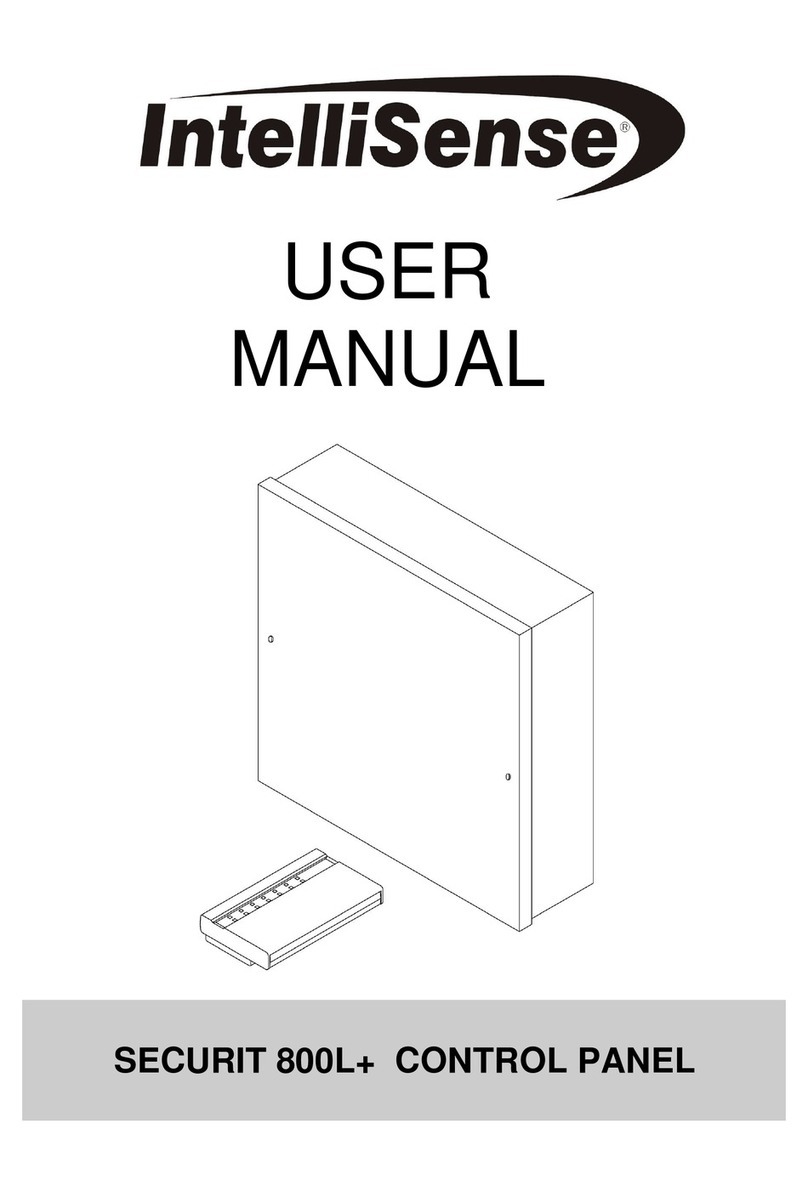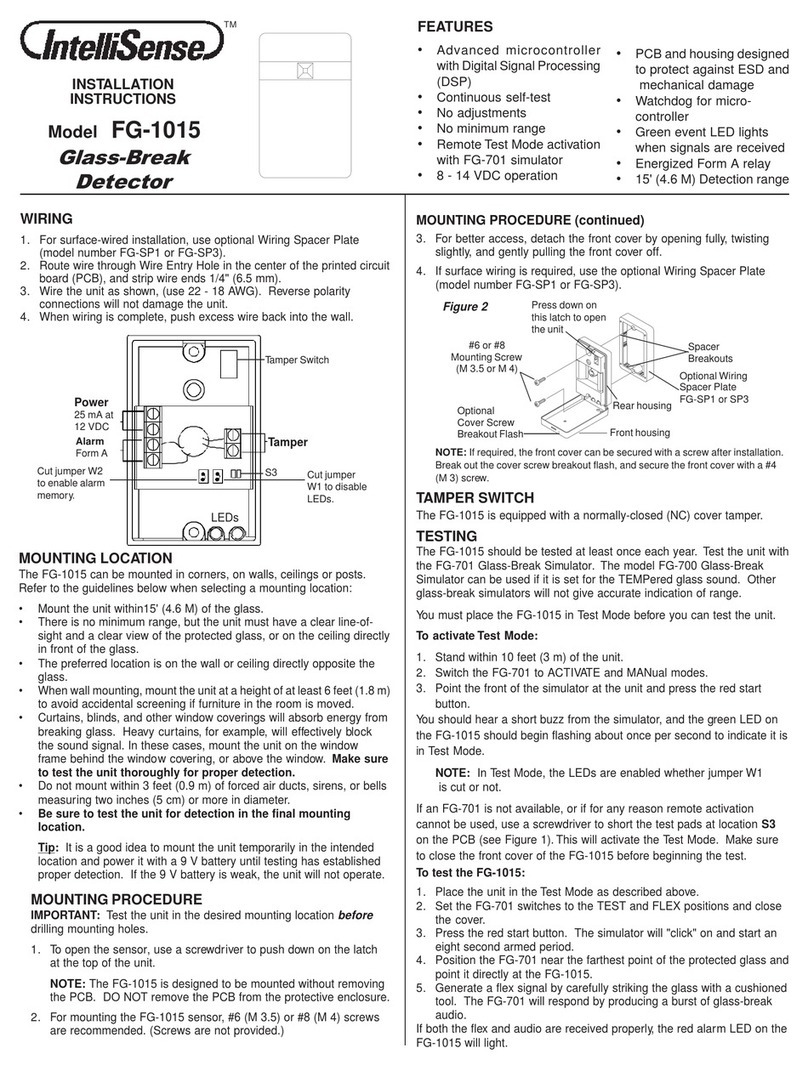No adjustment on audio
MOUNTING PROCEDURE
Orient the unit as shown in Figure 1. Remove the screw located at its top.
While depressing the latch near the top of the unit, swing the front cover
forward. Use the bac cover as a template to mar holes for the mounting
screws and wiring, then drill the holes.
The unit must have a direct line of sight to, and a clear view of,
the protected glass.
The FG-930 can be mounted on walls, in corners, even on false or suspended
ceilings. Refer to the guidelines below when selecting a mounting location.
MOUNTING LOCATION
Locate the FG-930 within 30' (9 m) of the glass to be protected.
Curtains, blinds, and other window coverings will absorb energy
from brea ing glass. Heavy curtains, for example, will effectively
bloc the sound signal. In these cases, mount the unit on the
window frame behind the window covering, or above the
window. Make sure to test the unit thorough y for proper
detection.
Do not mount the unit in front of air ducts or forced air fans, or
close to bells measuring 2" (or larger) in diameter.
Dual flex/audio technology
FEATURES
Separate microphones for
audio and flex detection
Energized form C alarm relay
with voltage supervision
RF immunity
Indicator LEDs
8 - 14 VDC operation
Low 30 mA at 12 VDC current
draw
Advanced acoustic filter to
prevent microphone overload
Cover tamper switch
Noise burst rejection circuit
Adjustment on flex detection
to fit characteristics of each
location
Transient protection
Alarm memory
The FG-930 from IntelliSense is a dua techno ogy glassbrea detector that
uses flex detection and audio discrimination to detect brea ing glass.
The FG-930 uses separate microphones to sense flex and audio frequen-
cies. The flex microphone is sensitive to ultra low frequencies, the type
generated by a blow to a glass window. The audio microphone detects the
higher frequencies of brea ing glass.
The flex microphone is also equipped with an advanced acoustic filter for
more stable flex detection. This filter is specially designed to prevent the
microphone overload caused by very loud sounds.
The FG-930's audio technology remains off until the flex technology detects
a blow to the glass. For an alarm condition to occur, the audio must detect
the frequency of brea ing glass within a defined time-window after the flex
detects a blow to the glass.
Because both technologies must detect and verify glass brea age, fa se
a arms are virtua y e iminated.
Tamper
Form A (NC)
50 mA, 30 VDC
Power
8 - 14 VDC
30 mA typical at 12 VDC V+
V-
C
NC
Figure 2 FG-930 Terminal Strip
NC
C
NO
A arm
Form C
500 mA max, 24 VDC max,
30 VA max
To adjust the flex technology of the FG-930: Use a screwdriver to set the
flex sensitivity control (R5) at MAXIMUM by turning it all the way cloc wise.
Refer to Figure 3 on the bac side of this page.
Turn on any heating/air conditioning system in the vicinity and observe the
yellow flex LED (DS2) for approximately one minute. Excessive subsonic
(inaudible) noise typically produced by air handling systems may cause
the flex LED to flash randomly.
If it flashes randomly, turn the R5 control countercloc wise just until the
flashing stops.
FLEX ADJUSTMENT
For corner mounting
(score and pull flap open)
REAR HOUSING
FRONT HOUSING
For surface mounting
After removing screw at top of
unit, depress this latch to open
housing
Figure 1 Mounting the FG-930
Observing the proper polarity, wire the unit as shown in Figure 2. (Use 22
to 14 AWG.) Reverse-polarity connections will not damage the unit.
WIRING
Wire Entry
Knoc outs
•
•
•
•
•
•
•
•
•
•
•
•
•
•
•
•
•
•
Pull the wiring into the unit through the bac cover. Using the two mounting
screws, mount the rear housing at the desired location.
Note: If you plan to corner-mount the unit, remove the printed
circuit board before mar ing and drilling holes for the mounting
screws.
Tip: If mounting the FG-930 near heavy machinery or central air
conditioning, test the glass-brea function before mounting. Use
a 9 V battery for power, and tape the sensor to the desired
mounting location. Refer to the Flex Adjustment, Testing the FG-
930, and Final Testing sections to determine which location will be
most suitable.
F exGuard-P us
TM
Dual Technology
Glassbrea Detector
INSTALLATION INSTRUCTIONS
Mode
FG-930 30' range max
























